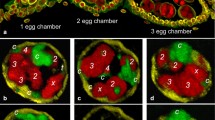Summary
Fifteen ring canals or intercellular bridges connect the oocyte and 15 nurse cells in Drosophila. Recently, Koch and King (1969) proposed that these ring canals formed independently of a cell furrow and that cytokinesis during the 4 cell divisions producing the 16 cells occurred through fusion of vesicles aligned along the division plane. Serial sections of germaria, fixed with glutaraldehyde, have been studied with the electron microscope, and no evidence has been found for fusion of vesicles in the cleavage of cells. The probability that the chromate-OsO4 fixation used by Koch and King resulted in an artifact is discussed.
Similar content being viewed by others
References
Bajer, A.: Fine structure studies on phragmoplast and cell plate formation. Chromosoma (Berl.) 24, 383–417 (1968).
Behnke, O.: An electron microscope study of the rat megacaryocyte. II. Some aspects of platelet release and microtubules. J. Ultrastruct. Res. 26, 111–129 (1969).
Buck, R. C., Tisdale, J. M.: An electron microscopic study of the development of the cleavage furrow in mammalian cells. J. Cell Biol. 13, 117–125 (1962).
Burgos, M. H., Fawcett, D. W.: Studies on the fine structure of the mammalian testis. I. Differentiation of the spermatids in the cat (Felis domestica). Biophys. biochem. Cytol. 1, 287–300 (1955).
Chandley, A. C.: Studies on oogenesis in Drosophila melanogaster with 3H-thymidine label. Exp. Cell Res. 44, 201–215 (1966).
Franzini-Armstrong, C., Porter, K. R.: Sarcolemmal invaginations constituting the T system in fish muscle fibers. J. Cell Biol. 22, 675–696 (1964).
Frasca, J. M., Parks, V. R.: A routine technique for douple staining ultrathin sections using uranyl and lead salts. J. Cell Biol. 25, 157–161 (1965).
Hay, E. D.: Electron microscopic observations of muscle dedifferentiation in regenerating Amblystoma limbs. Develop. Biol. 1, 555–585 (1959).
Koch, E. A., King, R. C.: The origin and early differentiation of the egg chamber of Drosophila melanogaster. J. Morph. 119, 283–304 (1966).
—: Further studies on the ring canal system of the ovarian cystocytes of Drosophila melanogaster. Z. Zellforsch. 102, 129–152 (1969).
Lentz, T. L., Trinkaus, J. P.: A fine structural study of cytodifferentiation during cleavage, blastula and gastrula stages of Fundulus heteroclitus. J. Cell Biol. 32, 121–138 (1967).
Mahowald, A. P.: Ultrastructural differentiations during formation of the blastoderm in the Drosophila melanogaster embryo. Develop. Biol. 8, 186–204 (1963).
—, Strassheim, J. M.: Intercellular migration of centrioles in the germarium of Drosophila melanogaster. An electron microscopic study. J. Cell Biol. 45, 306–320 (1970).
Pehlemann, F.-W.: Die amitotische Zellteilung. Eine elektronenmikroskopische Untersuchung an Interrenalzellen von Rana temporaria L. Z. Zellforsch. 84, 516–548 (1968).
Porter, K. R., Machado, R. D.: Studies on the endoplasmic reticulum. IV. Its form and distribution during mitosis in cells of onion root tip. J. biophys. biochem. Cytol. 7, 167–180 (1960).
Robbins, E., Gonatas, N. K.: The ultrastructure of a mammalian cell during the mitotic cycle. J. Cell Biol. 21, 429–463 (1964).
Rosenbluth, J.: Contrast between osmium-fixed and permanganate-fixed toad spinal ganglia. J. Cell Biol. 16, 143–157 (1963).
Thomas, R. J.: Cytokinesis during early development of a teleost embryo: Brachydanio rerio. J. Ultrastruct. Res. 24, 232–238 (1968a).
—: Yolk utilization during early development of a teleost embryo (Brachydanio rerio). J. Embryol. exp. Morph. 19, 203–215 (1968b).
Tormey, J. McD.: Differences in membrane configuration between osmium tetroxide-fixed and glutaraldehyde-fixed ciliary epithelium. J. Cell Biol. 23, 658–664 (1964).
Yamada, E.: The fine structure of the megakaryocyte in the mouse spleen. Acta anat. (Basel) 29, 267–290 (1957).
Author information
Authors and Affiliations
Additional information
The author gratefully acknowledges the assistance of Mrs. Joan Chlebowski; and the support of National Science Foundation grants GB-9780, GB-5780 and GB-24956; National Institutes of Health grant RR-05539; and an appropriation from the Commonwealth of Pennsylvania.
Rights and permissions
About this article
Cite this article
Mahowald, A.P. The formation of ring canals by cell furrows in Drosophila . Z. Zellforsch. 118, 162–167 (1971). https://doi.org/10.1007/BF00341561
Received:
Issue Date:
DOI: https://doi.org/10.1007/BF00341561




